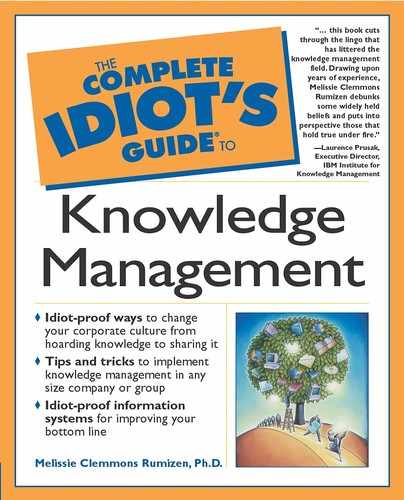
Chapter 23
Where Did We Go Wrong?
In This Chapter
▶ Implementing IT for the right reasons
▶ Understanding the importance of critical differences
▶ Building broad support
▶ Recognizing unrealistic timelines
I hate it when I see the signs of certain failure. I struggle for something tactful to say. I frantically think of ways to change their minds. Above all, I tell myself, I must radiate calm, rationality, and hope. What I want to do is say as gently as I can, “Turn the ship around. You’ll never reach port the way you are going. You need to change course.” What I’d prefer to do is congratulate you on the soundness of your knowledge management approach, applaud your certain success, and ask you to tell your story to others. The world needs to learn from you. You’re from a company that has used knowledge management to its fullest, another Hewlett-Packard Consulting or British Petroleum.
We’ve already discussed some potential pitfalls, such as failing to link knowledge management to business strategy, ignoring the importance of middle management, and bypassing users. But to increase the chances for the second scenario, this chapter will be devoted to other common pitfalls in implementing knowledge management initiatives. These are the things that drive me mad—and make knowledge management programs fail.
Build IT and They’ll Come
We’re doing knowledge management, they say to me. We’re implementing
▶ A corporate portal—one corporate portal—for everybody.
▶ This fabulous database filled with every kind of data field we could think of.
▶ Groupware (fill in name).
No matter what the name or technology, the message is that implementing an information technology solution equates to “doing” knowledge management. Unfortunately, that’s not how it works, folks.
I think the underlying belief here is that “people need more information.” Forget that some surveys find that people are receiving upwards of 300 e-mails per day. Forget that there are vast hordes of dusty, unused databases. Forget that some intranets closely resemble a junkyard filled with rusting hulks.
Let’s go back to our definition of knowledge: information in context to produce an actionable understanding. I’ll agree that knowledge workers need information in context as they do their jobs. But information and technology for information doesn’t necessarily give them what they need for action. What they need is something that gives context to information and makes it actionable.

Know How
People-based strategies do need supporting information technology. For example, communities of practice need a virtual workspace. This space should have areas for discussion, both private and public. There should be access to the documents and other tools the community develops. Other information sources used by the community should be available, such as Web sites and databases.
Sometimes there’s no underlying thinking. No one has thought through how the information technology will help meet business strategies and goals. No one has thought through whether it is the only solution or only one part of what should be a combined solution involving clear management expectations, defined roles and responsibilities, and reward mechanisms. (To keep from falling into the pitfall of information technology gone wrong, use the following checklist:
• Stamp out solutions looking for problems. (Let them take out a personal ad.) Any information technology must serve a business purpose. It must help people to do real work, solve real problems, and support real strategies.
• Consider the wetware—the users. Even if a database application is the best solution for your business needs, it doesn’t matter unless people use it. Design it to support the work process of actual people. Work on the design until the users can get excited about how much easier it made their jobs. I spot a problem when someone talks on and on about the technology without ever mentioning the users (or what a darn nuisance they are). When confronted with this folly I ask, “Where are the people?”
• Use change management in the deployment. No matter how good the information technology is, it’s a change.

Know How
In 1996, the editorial department at CIO magazine implemented Lotus Notes. Good folks on a cross-functional committee spent months considering programs and recommended implementing Notes. A project team including actual workers helped develop the applications. Then the technology was launched.
Unreasonable expectations had been set … and went unmet. There were numerous technical problems. The pilot application was overloaded with features, obscuring the useful ones. Training was poor. There was no clear sponsorship of the change. Worst of all, the application was a solution in search of a problem. Outside experts in change management were brought in to make recommendations. Sadder but wiser, the group put the application on hold until the glitches could be fixed.
Ignoring Critical Differences
I used to be on a team with all of the other members coming from another part of the organization. I’d get in my car, drive 10 miles, meet with them, and drive back. In due course, the meeting notes would pop up in my e-mail. But I couldn’t read them. Our information technology systems were different, and I couldn’t open any attachments from their system. Information technology is one of the differences that make it difficult to scale up a knowledge management approach. Not everyone has the same information technology infrastructure across an entire organization. Starting over again and building one is a sizeable investment, one your organization may not be willing to make for something as new as knowledge management.
When planning an approach that incorporates an information technology application, be sure to analyze your current infrastructure. Also talk to the IT people about what changes are coming down the pike. What works today may not work in three months after the operating system has been upgraded to a new version.

Know Nos
Even if you think you’re one of the lucky ones, think again. Applications can function differently on different models of a computer. So even if your entire corporation has Dinkydo computers, a difference in models here and there could create glitches you’d not anticipated. Another potential glitch is different versions of the same software. It seems like a small thing, but it can cause problems.

Know How
Chevron began its initiative for sharing knowledge and best practices in 1992. When I heard then-CEO Ken Derr speak in 1998, one of the first things he mentioned was that Chevron had standardized its information technology infrastructure across the entire corporation. A common information technology infrastructure is a tremendous enabler of knowledge management. The lack of one is a big stumbling block.
Cultural differences are another potential stumbling block. Hewlett-Packard Consulting found that in the United States the sharing of tacit knowledge was weak. HPC therefore focused on communities of practice and the project snapshots. The goal was to accustom people to sharing their knowledge and experiences.
In contrast, in Japan the sharing of explicit knowledge was relatively weak, although the Japanese were quite skilled at sharing tacit knowledge. In Japan, the focus was on building a repository to share documents.
Another difference often tied to culture is language. Many global organizations solve this by declaring that corporate language is English. Indeed, the aviation industry decreed years ago that the language of the skies would be English.
But it’s not that simple. Language skills and the opportunity to practice them vary from person to person. Some languages are much harder to learn, depending on what your native language is. There are also critical differences in the graphic representation of languages, ranging from different alphabets to different characters. Xerox dealt with this problem when it launched its Eureka system. Eureka was initiated in France, but once it was ramped up worldwide, it had to deal with input in eight different languages. Tips submitted by technicians can be in any language. Reviewers are bilingual. Approved tips are translated into English with the original language kept as an attachment. Another potential stumbling block is a difference in subcultures. This could be different functions, markets, product lines, geographies, or units. For example, in most organizations, marketing is different from research and development. Refining units in the oil companies are different from the discovery and exploration units. An office in the Boston area may be different from one based in the San Francisco area.
The bottom line is that one size doesn’t fit all. Consider carefully the differences across your organization that could impact your knowledge management strategy and approaches. Then figure out how to take advantage of these differences and learn from each other to the benefit of all.
Be aware that the flip side of trying to accommodate differences is that you could wind up with a many-headed knowledge management monster that’s difficult to implement and manage. That’ll be one of the challenges you face as you scale up. One solution is to develop policies and procedures that are flexible enough to work across the organization, but specific enough to produce some consistency. In particular, you need to make sure that there are consistent information technology standards.
A Kinder, Gentler Place by Tomorrow
I sometimes think some organizations can be classified as either hares or tortoises. The hares I meet are harried (couldn’t resist that one) and frantic. They tell me that their senior management or CEO has decided that they must do knowledge management. Their due date for delivering a plan is one month. They must implement within two months. Complete and overwhelming success is expected within three. World poverty is to be eradicated in four. I keep wondering when these folks will get around to reducing gestational time for a human baby from nine to three months.
Most organizations go through a gestational phase of discovery and exploration. The idea catches the imagination of someone within the organization. They find others who have the bug or are willing to catch it. Discussions start, but ignorance leads people to go outside to see what others are doing. They attend conferences, visit other organizations, and read voraciously. They join organizations and consortia.
As their understanding grows, they begin to flesh out a vision for their organization. They start preaching knowledge management, buttonholing any and everyone who will listen. They round up organizational support and find sponsors. They identify opportunities. They start locking down resources. The slow build to implementation is underway. I’ve done this myself, and it took more than three months. In contrast, what I see from the hares is …

Know How
A change agent must coldly analyze the odds for success. Some battles can’t be won. Unrealistic timelines are a good clue that management lacks an adequate understanding, another portent of failure. I know it’s hard to walk away when it’s something you believe in. The first time you do it, you’ll doubt yourself. But over time you’ll have more confidence in your ability to pick your battles.

Know Nos
Sometimes people set themselves up to become hares. They convince a senior sponsor or CEO that there is no time to waste, and are told to get it done right away. Be careful what you wish for. Keep in the back of your mind that if you preach knowledge management, you may have to deliver someday. That day could come before you’re ready.

Didn’t Know
Aware of their cultural diversity, Hewlett-Packard Consulting hired a cross-cultural consultant. This consultant understood the differences in values and attitudes in the context of sharing and leveraging knowledge. You may want to consider this as well, because deliberately involving people from diverse cultures also helps you to identify and target differences.

Know Nos
Don’t assume that having subcultures is bad. To the contrary, subcultures can be a sign of a healthy, well-functioning organization. Specialized subcultures can be more efficient, helping an organization to perform well in different environments.
▶ Ill-defined vision and goals.
▶ Poorly thought-out links, if any, to business strategy and goals.
▶ Hastily chosen approaches.
▶ Inadequate organizational support from key leaders and other players.
▶ Lousy execution of approaches marked by major setbacks.
▶ Poorly demonstrated (if demonstrated at all) benefits and return on investment.
My answer to the ones giving the hares their orders is to ask if they want it done right or done on time. I do realize this is a bit hard to say to a CEO (I don’t enjoy it, let me tell you). But, I prefer to do that instead of tap dancing my way around an utter failure later.
If you’re implementing knowledge management, you want to prime for success. For that you need time. Resist the fear that this may be your only chance. I’ll guarantee you that if you fail now, you’ll increase the odds that it’ll turn out to be your only chance.
The flip side of this quandary is the tortoise that never reaches the finish line. Organizations vary, but many tolerate only so much discovery and preparation.
I’ll admit that one of my major lessons learned early as a change agent was that if I waited until I had something perfect, the opportunity was long gone. Besides, it’s impossible to get something right the first time out of the gate no matter how long you study and plan. I’ve resigned myself to doing the best job I can within a reasonable amount of time.
Tortoises need to keep that lesson in mind, then develop a balance between the time they need and the time the organization will allow. One of the keys to success in any innovation or change is building momentum and finding a way to sustain it. It’s hard to rekindle a fire that has gone out.
Betting the Farm on a CEO or Other Sponsor
Who wouldn’t want the CEO passionately committed? Or the chief operating officer? Or the company president? Or the head of a strategic business unit? You’re right, it’s good to have high-level sponsors. The higher, the better. The more, the better.
The head of an organization, of course, has extraordinary power. With the CEO firmly behind your effort, it’s like being on a superhighway in a Formula 1 racecar. Doors open, funds appear, barriers vanish. Even if your sponsor isn’t the top dog, having someone at senior levels is also magical. In every successful knowledge management effort that the American Productivity and Quality Center has studied—and they’ve looked at a bunch—an important senior sponsor or sponsor group pushed for the initiative.

Didn’t Know
Tom Young, formerly of British Petroleum and now of Knowledge Transformation International, tells of the day that he went to discuss the knowledge management program with a senior manager. As he came in, the manager asked him if he wanted a cup of coffee. Tom did, and someone scurried off to get it for him. When the coffee arrived the manager told him, “Drink your coffee, Tom. There’s no need to talk to me. The top guy is behind it, so I am, too. That’s enough for me.” This baffled Tom, prepared for perhaps a lengthy back-and-forth discussion on the merits of the program. But he drank his coffee and left.
However, I wouldn’t bet the farm on just one sponsor or sponsor group. That gives me the heebie-jeebies. Unless you foster wider organizational support, your lifeline is tethered to one person or group. A sad fact of organizational life is that people leave, sometimes of their own free will and sometimes not. I don’t care if your sponsor is the CEO. What guarantee do you have the CEO will be there for the life of the program? What guarantee do you have that a replacement will have the same passion and commitment? The same holds true for any sponsor.
Granted, once the sponsor is on board, many people fall in line behind the effort. What worries me is their sincerity. There’s a big difference between compliance and commitment. Hopefully the initial compliance will give knowledge management a chance to prove itself. The outward compliance will turn into inward belief.

Know Nos
A potential pitfall is having a program with no distinct business objectives. Goals like “change the culture to one of openness, foster collaboration, and become a knowledge-based organization” seem hard to argue with. But you need to have that clear link to business strategies, and for that you need business objectives. The World Bank’s mission is to eradicate world poverty. Their knowledge management program has specific business objectives to achieve that mission.
This doesn’t always happen, though. There will always be people who are KM believers in name only, and if the top-level sponsor leaves the organization, their outward compliance can change back into overt resistance. That’s another reason betting the farm on a sole sponsor, no matter how heroic or charismatic, is risky.
The flip side of this is launching with what seems like adequate support from a sponsor or sponsor group, only to have the support eventually dry up. This can be hard to diagnose up front. An organization can assign a chief knowledge officer, create a budget, and sign up other resources. There are meetings at which high-flown rhetoric on the noble ambitions of the program fills the air. Approaches are identified. Sometimes outside consultants are brought in as well. Things appear to be going well.
But the backbone to confront knotty issues like the cultural assumptions needed for successful implementation isn’t there. The people working on knowledge management, whether internal or external, can’t seem to get any traction. When they ask management for support, management avoids taking any action. Instead, the KM people find themselves endlessly pushing a limp strand of spaghetti. This can even happen when a program shows success initially, just when you’d think that it’s time to shift into high gear. In those situations, if an organization is brave, it’ll face up to the fact that it wasn’t ready after all. If not, my advice is to look for another job. Things aren’t going to work where you are.
Luckily, some organizations select out. Unable to define knowledge management, the goals for it, and how it can enable their business strategy, they never get off the ground. I’ve seen some that can’t even get their act together enough to hire a CKO. A potential flip side of this problem is sponsors who are committed to making knowledge management succeed but don’t understand what their role needs to be. I call them absentee landlords. Sponsors and the rest of management need to be hands-on, from the beginning through implementation through scaling up and to maintaining the effort. My advice is to spell out what’s expected of them. No matter what stage you’re in, they’ll need to
▶ Communicate constantly that knowledge management is critical for the organization’s success.
▶ Interact frequently with the KM team.
▶ Enlist the support of other senior leaders.
▶ Buy the time needed to demonstrate the value.
▶ Press for defined and reachable goals.
▶ Monitor progress.
▶ Role model knowledge sharing activities.
Stopping Before You’re Done
A successful pilot doesn’t mean a successful program. It means there’s been a good start, but there’s still plenty of work left to do to embed knowledge management firmly in the organization. We’ll discuss what’s left to be done in the next chapter.

Didn’t Know
To help its sponsors understand their role, Hewlett-Packard Consulting told the story of Moses leading the children of Israel to the Promised Land. Moses had a high-level sponsor who removed barriers for him. He led the decades-long journey, continuing a high level of involvement throughout. At the end of the story the new vice president and general manager of HPC volunteered to be Moses. He was a hands-on participant in the development of the KM initiative. He communicated the importance of KM to HPC. He worked on getting and keeping the support of the rest of his senior leadership team. He also worked closely with the KM team.
The Least You Need to Know
▶ Information technology, no matter how good, doesn’t equate to knowledge management. Build it and they may yawn in your face.
▶ You’ll have to consider potential differences in culture, organizational subcultures, and language. You may have to adjust to accommodate them.
▶ While accommodating differences you also need to worry about standardization.
▶ You need broad organizational support from leaders at multiple levels. Never bet the bank on just one sponsor.
▶ Spell out to your sponsors exactly what they should do. In particular, make sure they have enough time.
▶ Implementing knowledge management takes time. Unrealistic deadlines set you up for failure.
..................Content has been hidden....................
You can't read the all page of ebook, please click here login for view all page.
